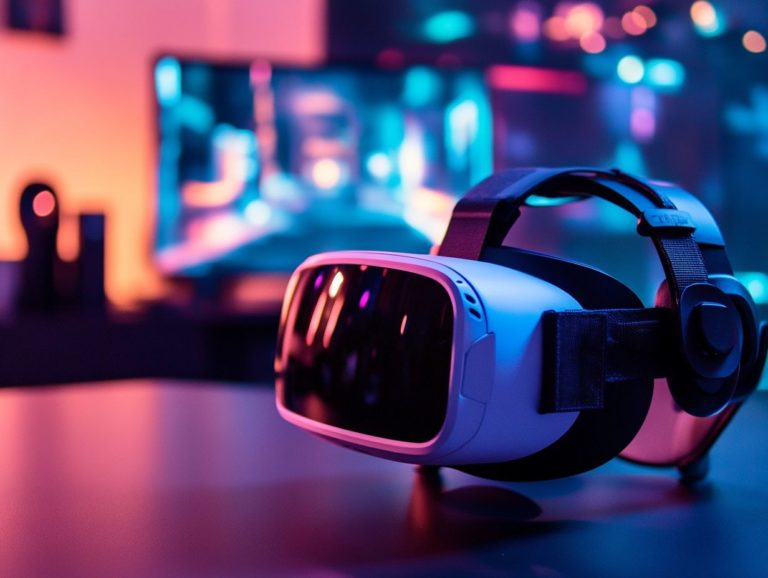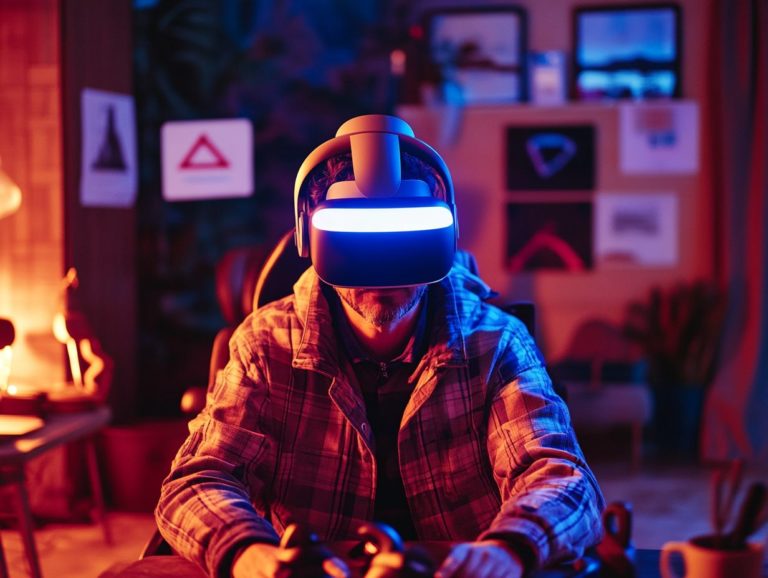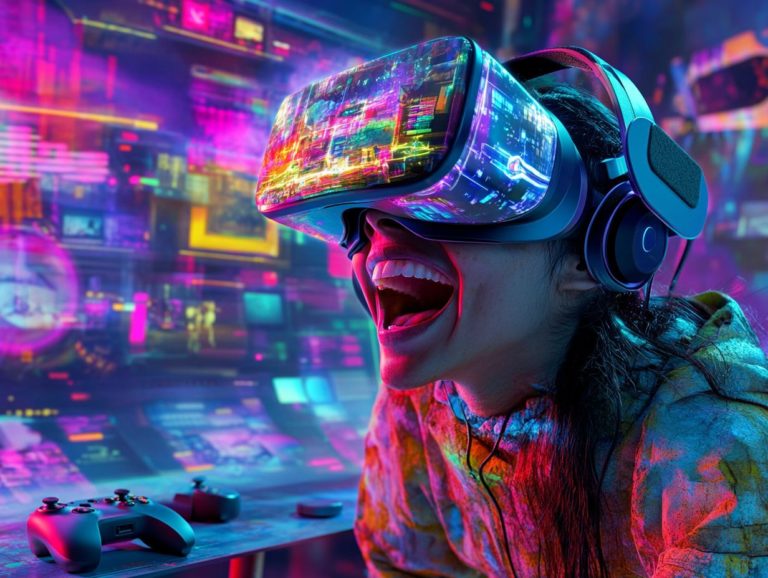how vr is used in therapy and rehabilitation
Virtual Reality (VR) is revolutionizing therapy and rehabilitation, presenting groundbreaking solutions that elevate patient engagement and foster improved outcomes!
In this article, you will discover the myriad benefits of VR. It spans applications in mental health treatment and physical rehabilitation. You ll see how VR enhances motivation and treatment efficacy, while also addressing crucial considerations like equipment requirements and ethical implications.
The future is poised to broaden the possibilities of VR in therapeutic contexts. Join the exploration of the thrilling potential that VR holds for modern therapy!
Contents
- Key Takeaways:
- Benefits of VR in Therapy and Rehabilitation
- Applications of VR in Therapy and Rehabilitation
- Considerations When Using VR in Therapy and Rehabilitation
- Future of VR in Therapy and Rehabilitation
- Frequently Asked Questions
- What is virtual reality therapy and rehabilitation?
- How is VR used in physical therapy and rehabilitation?
- What are the benefits of using VR in therapy and rehabilitation?
- Is VR therapy and rehabilitation safe?
- What conditions can VR therapy and rehabilitation treat?
- Is VR therapy and rehabilitation covered by insurance?
Key Takeaways:
VR therapy enhances patient engagement and motivation, leading to improved treatment outcomes. VR technology is utilized in various applications, such as mental health treatment and physical rehabilitation. When using VR in therapy, think about equipment, training requirements, and ethical and privacy concerns.
What is VR Therapy and Rehabilitation?
Virtual Reality (VR) Therapy and Rehabilitation offers an innovative way to harness the power of VR technology. It creates immersive environments that transform the experience of physical therapy.
By simulating real-world scenarios, VR therapy enhances your treatment process, especially if you’re dealing with neurological disorders like stroke or movement disorders. This approach uses assistive technology, which includes tools that help individuals with disabilities improve their quality of life, adding a dynamic layer of interaction and engagement to your rehabilitation journey.
At the core of VR therapy are elements designed to captivate your senses. These include interactive visual and auditory stimuli that engage you far more deeply than traditional methods.
These immersive environments allow you to practice movements in a controlled setting. You can repeat tasks that promote the brain s ability to adapt and change. The technology integrates seamlessly with conventional therapy practices, providing real-time feedback and motivational features that boost your commitment to rehabilitation programs.
This powerful combination makes exercises fun and exciting! You ll nurture a sense of accomplishment as you witness your progress firsthand. Ultimately, this leads to improved outcomes and a faster return to your daily activities.
Benefits of VR in Therapy and Rehabilitation
The benefits of Virtual Reality (VR) in therapy and rehabilitation are nothing short of transformative, particularly when it comes to enhancing your motivation and engagement during treatment sessions.
By utilizing the power of immersive distraction techniques, VR can fundamentally change the treatment landscape. You can enjoy exercise sessions while keeping your rehabilitation goals front and center.
Improved Engagement and Motivation
Improved engagement and motivation in patients undergoing rehabilitation stand out as key advantages of VR therapy. It skillfully employs gamified techniques to transform therapy sessions into enjoyable and effective experiences.
By immersing you in interactive gaming environments, VR therapy creates a compelling experience that encourages your active participation. Elements like scoring systems, challenges, and real-time feedback keep you focused and motivated, turning monotonous repetitions into thrilling missions!
Tools such as virtual simulations and customizable avatars enable you to set personal goals, fostering a sense of ownership and achievement. Social features like multiplayer options enhance camaraderie, making your rehabilitation a collaborative effort rather than a solitary task.
These strategies sustain your interest while promoting a deeper commitment to your recovery journey.
Ready to transform your rehabilitation experience? Discover the possibilities of VR therapy today!
Enhanced Treatment Outcomes
VR therapy can significantly improve your treatment outcomes, especially in pain management and functional recovery.
With advanced virtual environments, healthcare providers monitor your progress and assess your movements accurately.
This technology supports custom therapy and provides real-time feedback. You and your therapist can track improvements effectively.
If you are in physical therapy for an injury, immersive exercises can boost your mobility. If you’re dealing with chronic pain, distraction techniques can help reduce discomfort.
Integrating VR into rehabilitation is transforming traditional methods, making therapy more engaging and effective.
Applications of VR in Therapy and Rehabilitation
VR has diverse applications in therapy and rehabilitation, addressing mental health and physical recovery needs.
By using VR, innovative solutions can enhance psychological well-being and physical recovery, improving patient care.
Mental Health Treatment
VR is changing mental health treatment by offering immersive experiences that evoke emotions and aid cognitive therapy.
These environments help you confront fears, practice social skills, and manage anxiety in a safe space.
Techniques like exposure therapy and mindfulness fit seamlessly into virtual settings. For instance, Virtual Reality Exposure Therapy, or VRET, has shown to reduce symptoms for those with PTSD and anxiety.
Your feedback is crucial for customizing experiences, ensuring interventions are engaging and effective.
Physical Rehabilitation
VR therapy provides groundbreaking approaches in physical rehabilitation, especially for those with upper limb impairments or recovering from strokes.
Engaging in captivating virtual environments can motivate you to perform targeted movements without the intimidation of traditional therapy.
Movement tracking gives you real-time feedback, ensuring your exercises are performed correctly and adjusted as you progress.
For example, VR systems like the Kinect let you play interactive games that make therapy enjoyable while incorporating essential therapeutic techniques.
Considerations When Using VR in Therapy and Rehabilitation
When using VR in therapy, consider equipment needs, training, and patient privacy.
These factors are crucial for a seamless and responsible VR implementation in therapy.
Equipment and Training Requirements
Integrating VR in therapy requires specific equipment like VR headsets and therapy tools, along with training for healthcare providers.
The HTC Vive stands out for its immersive capabilities and tracking accuracy, ideal for rehabilitation exercises.
These tools engage patients and provide valuable data for treatment plans. However, it’s essential that healthcare professionals receive thorough training to use these devices effectively.
This integration into existing healthcare practices leads to better patient outcomes and a smoother rehabilitation process.
Ethical and Privacy Concerns
Ethical and privacy concerns are critical when implementing VR in therapy. You must manage patient data and emotional responses carefully.
As you explore the transformative potential of VR, it s important to ensure confidentiality. Obtaining informed consent helps patients understand how their data will be used and the associated risks.
Robust protocols are vital for prioritizing emotional safety during VR experiences. By fostering trust and transparency, you can enhance the therapeutic process and address ethical dilemmas effectively.
Future of VR in Therapy and Rehabilitation
The future of VR in therapy is filled with exciting possibilities.
With emerging technologies paving the way, you can expect significant advancements in rehabilitation strategies and improved patient outcomes.
Emerging Technologies and Possibilities
Emerging technologies in VR are revolutionizing rehabilitation strategies, enhancing patient education, and improving self-care skills through innovative tools that help patients recover.
The integration of artificial intelligence allows for personalized therapy experiences that adapt to your individual needs and progress.
Imagine engaging with augmented reality that immerses you in realistic environments, helping you practice real-world tasks as you navigate your recovery.
Enhanced interactive gaming platforms engage you in ways that traditional methods simply can’t match, making rehabilitation not just effective but also enjoyable.
These technologies promise to facilitate remote healthcare delivery, expanding access for individuals in underserved areas.
For healthcare providers, monitoring your progress in real-time leads to more efficient, tailored treatment plans, ultimately enhancing your outcomes.
Frequently Asked Questions
What is virtual reality therapy and rehabilitation?
Virtual reality (VR) therapy and rehabilitation is a form of therapy that uses VR technology to create simulated environments for patients to interact with to address physical, emotional, and cognitive issues.
How is VR used in physical therapy and rehabilitation?
VR is used in physical therapy and rehabilitation to create immersive environments that simulate real-world scenarios, allowing patients to engage in therapeutic exercises in a safe and controlled setting.
What are the benefits of using VR in therapy and rehabilitation?
The benefits of using VR in therapy and rehabilitation include improved motor function, enhanced cognitive and sensory skills, reduced pain, increased motivation, and a more personalized treatment experience.
Is VR therapy and rehabilitation safe?
Yes, VR therapy and rehabilitation are considered safe when used under the guidance of a trained professional. The virtual environments can be adjusted to accommodate the patient’s individual needs, ensuring effective treatment.
What conditions can VR therapy and rehabilitation treat?
VR therapy can treat various conditions, including physical injuries, neurological disorders, anxiety, phobias, PTSD, and chronic pain. It is also effective for stroke rehabilitation and pain management.
Is VR therapy and rehabilitation covered by insurance?
As VR therapy is relatively new, insurance coverage may vary. It s important to check with your insurance provider and healthcare professional to determine coverage for these services.





